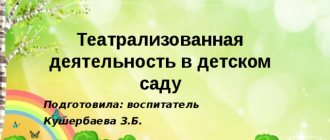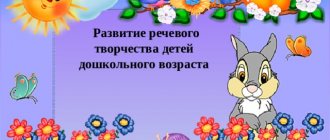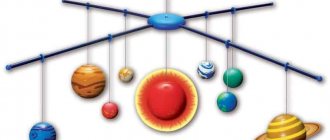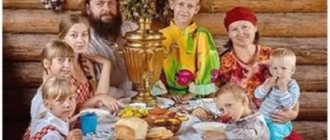Forms of working with books in kindergarten
Forms of working with books in kindergarten
Plan
| Introduction | 2 | |
| 1. | The importance of fiction in the development and upbringing of children. | 3 |
| 2. | Forms of working with books in kindergarten. | 5 |
| 3. | Literary evenings of leisure. | 8 |
| 4. | Organization and design of a corner for different age groups. | 10 |
| Practical part: | 15 | |
| 1. | Scenario of a literary evening in the preparatory group. | 15 |
| 2. | Photos of a book corner in each age group in the garden. Conclusions. | 19 |
| 3. | Sketch of a book corner. | 20 |
| Conclusion | 21 | |
| Bibliography | 22 | |
People stop thinking
when they stop reading.
(Diderot)
- Introduction
Preschool childhood as a period in human life plays an important role in shaping what not only each individual person will become, but also all of humanity and the world as a whole. The educational, ideological, moral, and cultural priorities laid down in preschool childhood determine the life path of generations and influence the development and state of the entire civilization.
It is necessary to pay as much attention as possible to the development of the child’s inner world. Communication with a book provides invaluable assistance in this. Through reading fiction, a child learns the past, present and future of the world, learns to analyze, and develops moral and cultural values.
Modern children spend more and more time playing computer games and watching TV. Sociological research in our country and abroad has revealed negative trends: interest in reading among younger preschoolers and adolescents is noticeably reduced; The share of reading in children's free time has been sharply reduced.
Today, in order to raise a reader in a child, an adult must himself show interest in a book, understand its role in a person’s life, know the books recommended for preschool children, be able to have an interesting conversation with kids and help in analyzing the work.
- The importance of fiction in the development and upbringing of children
Fiction serves as a powerful, effective means of mental, moral and aesthetic education of children; it has a huge impact on the development and enrichment of children's speech.
In poetic images, fiction reveals and explains to the child the life of society and nature, the world of human feelings and relationships. It makes emotions more intense, fosters imagination and gives preschoolers excellent examples of the Russian literary language. These samples vary in their impact; in stories, children learn the conciseness and precision of words, in poetry they capture the musicality, melodiousness, and imagery of Russian speech; folk tales reveal to them the accuracy and expressiveness of the Russian word, show how rich their native speech is in humor, lively and figurative expressions, and comparisons. Preschool children —
listeners, not readers, the work of art is conveyed to them by the teacher, so the mastery of expressive reading skills acquires special importance. The teacher faces an important task - each work needs to be conveyed to children as a work of art, to reveal its intention, to infect the listener with an emotional attitude towards what they read; feelings, actions, lyrical experiences of the characters1.
The ability to correctly perceive a literary work, to understand, along with the content, elements of artistic expression, does not come to the child by itself: it must be developed and educated from a very early age. In this regard, it is very important to develop in children the ability to actively listen to a work, to listen attentively to artistic speech. Thanks to these skills, the child will develop his own bright, imaginative, colorful, grammatically correct speech.
The importance of fiction in raising children is determined by its social, as well as educational role in the life of the entire people.
The art of words reflects reality through artistic images, shows the most typical, comprehending and generalizing real life facts. This helps the child learn about life and shapes his attitude towards the environment. Works of fiction, revealing the inner world of the heroes, make children worry and experience the joys and sorrows of the heroes as if they were their own.
The kindergarten introduces preschoolers to the best works for children and, on this basis, solves a whole complex of interrelated problems of moral, mental, and aesthetic education.
The process of development of aesthetic perception is very noticeable in preschool age. A child can understand that a work of art reflects the typical features of phenomena as early as 4-5 years old. Researchers note such a feature of a child’s artistic perception as activity and deep empathy for the heroes of the works. Older preschoolers acquire the ability to mentally act in imaginary circumstances, as if to take the place of the hero. For example, together with the heroes of a fairy tale, children experience a feeling of fear in tense dramatic moments, a feeling of relief, and satisfaction when justice triumphs.
A work of art attracts a child not only with its bright figurative form, but also with its semantic content. Older preschoolers, perceiving a work, can give a conscious, motivated assessment of the characters, using in their judgments the criteria of human behavior in our socialist society that they have developed under the influence of upbringing. Direct empathy for the characters, the ability to follow the development of the plot, comparison of the events described in the work with those that he had to observe in life, help the child relatively quickly and correctly understand realistic stories, fairy tales, and by the end of preschool age - shapeshifters, fables. The insufficient level of development of abstract thinking makes it difficult for children to perceive genres such as fables, proverbs, riddles, and necessitates the help of an adult.
Preschoolers are capable of mastering a poetic ear and can understand the basic differences between prose and poetry.
Children of senior preschool age, under the influence of the targeted guidance of educators, are able to see the unity of the content of a work and its artistic form, find figurative words and expressions in it, feel the rhythm and rhyme of the poem, even remember the figurative means used by other poets.
Thus, it is important to recognize the reading process as decisive in the education and development, ideological and moral formation of a person and a child.
- Forms of working with books in kindergarten.
Currently, in pedagogy, to define speech activity that has a pronounced aesthetic orientation, the term “artistic speech activity of children” has been adopted. In terms of its content, this is an activity related to the perception of literary works and their execution, including the development of initial forms of verbal creativity (inventing stories and fairy tales, riddles, rhymed lines), as well as imagery and expressiveness of speech.
It is clearly seen that this concept also includes the formation of coherent speech, vocabulary work, etc.
Ensuring that the child masters the content of the works and understands them correctly is an important task.
The teacher develops in children the ability to perceive a literary work.
Traditionally, in the methodology of speech development, it is customary to distinguish two forms of working with books in kindergarten: reading and telling fiction and memorizing poems and using literary works and works of oral folk art outside of class, in different types of activities2.
When introducing preschoolers to fiction, various methods are used to form a full-fledged perception of the work by children:
• expressive reading by the teacher;
• conversation about what you read;
• repeated reading;
• looking at illustrations;
• explanation of unfamiliar words.
A special place in children's reading is occupied by such a genre as a story for little ones. Reading the story, as noted by R.I. Zhukovskaya, gives the child the opportunity to follow the life and adventures of the same hero for a long time.
In early preschool age, children are taught a love and interest in books and illustrations, the ability to focus attention on the text, listen to it to the end, understand the content and respond emotionally to it. Children develop joint listening skills, the ability to answer questions, and a careful attitude towards books.
The teacher names the genre of fiction: “I’ll tell a fairy tale, read a poem.” After telling a fairy tale, the teacher helps the children remember interesting places, repeat the characteristics of the characters (“Peter the Cockerel, the golden comb,” “The turnip has grown big and big,” name repeated appeals (“Little goats, kids, open up, open up!”, “Terem-Teremok , who lives in the mansion?”) and actions (“They pull and pull, but they can’t pull it out.”) Helps you remember this material and learn to repeat it with different intonations.
In middle preschool age, the work of instilling in children the ability to perceive a literary work and the desire to respond emotionally to the events described deepens. Children's attention is drawn both to the content and to the form of the work that is easily distinguishable by ear (poetry, prose), as well as to some features of the literary language (comparisons, epithets). This promotes the development of a poetic ear and sensitivity to figurative speech. As in younger groups, the teacher names the genre of the work. It becomes possible to conduct a small analysis of the work, that is, a conversation about what has been read. Children are taught to answer questions about whether they liked the fairy tale (story), what it is about, what words it begins and what it ends with. A conversation develops the ability to think, express one’s attitude towards characters, correctly evaluate their actions, characterize moral qualities, and makes it possible to maintain interest in literary words, figurative expressions, and grammatical structures.
In older preschool age, a strong interest in books arises and a desire to listen to them read. The accumulated life and literary experience gives the child the opportunity to understand the idea of the work, the actions of the characters, and the motives of behavior. Children begin to consciously relate to the author's word, notice the features of language, figurative speech and reproduce it.
In working with children in this section of the program outside of class, two directions emerge: the first, when the teacher purposefully organizes preschoolers to perceive works, and the second, the independent use of works by children on their own initiative with the indirect participation of an adult.
A system of work to familiarize preschoolers with fiction
Sadykova Gulbara Almanovna, Koroleva Elena Olegovna, Municipal Educational Institution Center-kindergarten No. 390, teachers, VolgogradAbstract Fiction opens and explains to the child the life of society and nature, the world of human feelings and relationships. It develops the child’s thinking and imagination, enriches his emotions, and provides excellent examples of the Russian literary language
The impact of fiction on the mental and aesthetic development of a child is well known. Its role is also great in the development of the speech of a preschooler. The importance of introducing children to the beauty of their native word and the development of a culture of speech was pointed out by teachers, psychologists, and linguists (K. D. Ushinsky, E. I. Ttakheeva, E. A. Flerina, L. S. Vygotsky, S. L. Ru -binshtein, A.V. Zaporozhets, A.A. Leontyev, F.A. Sokhin, A.M. Shakhnarovich, L.I. Aidarova, etc.).
Its educational, cognitive and aesthetic significance is enormous, since by expanding the child’s knowledge of the world around him, it influences the child’s personality and develops the ability to subtly sense the form and rhythm of the native language.
Fiction accompanies a person from the first years of his life.
A literary work appears to the child in the unity of content and artistic form. The perception of a literary work will be complete only if the child is prepared for it. And for this it is necessary to draw children’s attention not only to the content, but also to the expressive means of language of a fairy tale, story, poem and other works of fiction.
Gradually, children develop a selective attitude towards literary works and an artistic taste is formed. All subsequent acquaintance with the vast literary heritage will be based on the foundation that we lay in preschool childhood. The main task of the teacher is to instill in children a love of the literary word and respect for the book.
Based on the analysis of a literary work in the unity of its content and artistic form, as well as in the active development of means of artistic expression, children master the ability to convey certain content in a figurative word.
By verbal creativity is meant the activity of children that arose under the influence of works of art and impressions from the surrounding life and is expressed in the creation of oral compositions - stories, fairy tales, poems, etc. The relationship between the perception of fiction and verbal creativity exists on the basis of the development of poetic hearing . This concept includes the ability to feel the expressive means of artistic speech and, to some extent, be aware of them. This also includes the ability to distinguish between genres, understanding their characteristics, and the ability to recognize the connection between the components of an artistic form and the content of a literary work.
The development of a poetic ear is an important factor in the formation of verbal creativity. However, the development of a poetic ear in itself does not lead to creativity, which can only be developed on the basis of special work aimed at creating conditions for children’s creative manifestations.
Speech culture is a multifaceted phenomenon; its main result is the ability to speak in accordance with the norms of the literary language; this concept includes all the elements that contribute to the accurate, clear and emotional transmission of thoughts and feelings in the process of communication. Correctness and communicative appropriateness of speech are considered the main stages of mastering a literary language.
In modern conditions, one of the dangers for literary speech is the influence of cliches, “bureaucrats” (K.I. Chukovsky), which deaden living speech. The habit of speaking in cliches, fused blocks of official words leads to the loss of a living language, and this is reflected in its grammatical side and the expressiveness of speech.
In pedagogical practice, a high level of speech culture is denoted using the term “good speech”. This concept includes three characteristics as minimally sufficient: richness, accuracy and expressiveness. The richness of speech presupposes a large volume of vocabulary, understanding and appropriate use of words and phrases in speech, and a variety of linguistic means used in speech.
Precision of speech can be considered as the optimal use of words: this is the choice of words that best convey the content of the statement, reveal its topic and main idea in a logical sequence. Here it is very important to master synonymy, to distinguish between the meanings of the semantic shades of a word.
And finally, the expressiveness of speech involves the selection of linguistic means that correspond to the conditions and tasks of communication. This quality must necessarily be correlated with a functional style and understanding of the situation, so that when choosing words and expressions, the specifics of speech conditions should be taken into account.
The development of figurative speech must be considered in several directions: as work on children’s mastery of all aspects of speech (phonetic, lexical, grammatical), the perception of various genres of literary and folklore works, and as the formation of the linguistic design of an independent coherent utterance. Works of fiction and oral folk art, including small literary forms (proverbs, sayings, phraseological units, riddles, tongue twisters), are the most important sources for the development of expressiveness of children's speech.
A preschooler initially understands a word only in its basic, direct meaning. With age, the child begins to understand the semantic nuances of a word, becomes familiar with its polysemy, learns to understand the figurative essence of artistic speech, the figurative meaning of phraseological units, riddles, and proverbs. An indicator of the richness of speech is not only a sufficient amount of active vocabulary, but also the variety of phrases used, syntactic structures, as well as the sound (expressive) design of a coherent utterance. In this regard, the connection between each speech task and the development of speech imagery can be traced.
Thus, lexical work aimed at understanding the semantic richness of a word helps the child find the exact word in the construction of a statement, and the appropriateness of using a word can emphasize its figurativeness.
Specially organized lexical work aimed at developing in preschoolers the ability to select lexical means that most accurately correspond to the revealed concept is considered in the context of the arbitrariness of constructing a coherent statement.
So, work on the semantic side of a word comes to the fore, since it is the semantic selection of words in accordance with the context and speech situation (disclosure of the meanings of a polysemantic word, the use of synonyms and antonyms) that has the most significant impact on the formation of awareness of the phenomena of language and speech.
In the formation of the grammatical structure of speech in terms of figurativeness, possession of a stock of grammatical means, the ability to feel the structural and semantic place of the word form in a sentence and in the whole utterance acquire special importance. It is here that a developed “sense of style” comes into play, the ability to use a variety of grammatical means (inversion, correlation of syntax with the topic of the statement, appropriate use of prepositions, etc.). Let us emphasize the role of synonymy of grammatical forms and constructions depending on their semantic shades, and their role in constructing a coherent statement. Syntactic structure is considered the main fabric of a speech utterance. In this sense, the variety of syntactic structures makes the child’s speech expressive.
If we consider the phonetic side of speech, then the intonational design of the statement largely depends on it, and hence the emotional impact on the listener. The coherence (smoothness) of the presentation of the text is also influenced by such characteristics of the sound culture of speech as the strength of the voice (loudness and correct pronunciation), clear diction, and tempo of speech.
In the formation of coherent speech, the relationship between speech and aesthetic aspects plays an important role. A coherent statement shows how much the child masters the richness of his native language, grammatical structure, and at the same time reflects the level of his mental, aesthetic and emotional development. The development of speech in preschoolers is closely connected with solving the problems of forming artistic and speech activity as one of the integral parts of the aesthetic education of children. Thus, teaching the retelling of folklore and literary works in order to develop in preschoolers the ability to construct a coherent monologue statement necessarily includes familiarizing children with the visual and expressive means of literary text (comparisons, epithets, metaphors, synonyms, etc.). At the same time, mastery of these means deepens and refines the artistic perception of literary works, which, including elements of a conscious attitude towards the literary text, retains its emotionally direct character, i.e. remains a truly aesthetic perception.
In the formation of creative storytelling, the child’s conscious attitude to language in its aesthetic function, which is manifested in the choice of linguistic figurative and expressive means for the embodiment of an artistic image, is very important.
The development of figurative speech is an important component of the education of a culture of speech in the broad sense of the word, which is understood as compliance with the norms of the literary language, the ability to convey one’s thoughts, feelings, ideas in accordance with the purpose and purpose of the statement in a meaningful, grammatically correct, accurate and expressive manner.
Speech becomes figurative, direct and lively if the child develops an interest in linguistic richness and develops the ability to use a wide variety of expressive means in his speech.
The most important sources for the development of expressiveness of children's speech are works of fiction and oral folk art, including small folklore forms (proverbs, sayings, riddles, nursery rhymes, counting rhymes, phraseological units).
The educational, cognitive and aesthetic significance of folklore is enormous, since, by expanding knowledge about the surrounding reality, it develops the ability to subtly sense the artistic form, melody and rhythm of the native language.'
The artistic system of Russian folklore is unique, the genre forms of works are extremely diverse - epics, fairy tales, legends, songs, ... legends, as well as small forms - ditties, nursery rhymes, riddles, proverbs, sayings, the language of which is simple, precise, expressive.
Among the expressive means of language, a certain place is occupied by phraseological units, the use of which gives speech special brightness, lightness, accuracy and imagery. Familiarizing preschoolers with small forms of folklore influences the development of understanding of the role of expressive means (comparisons, metaphors, epithets) in a literary text.
Working with phraseological units should attract children's attention to unusual expressions, and the selection of synonyms and antonyms for phraseological units develops an awareness of the general meaning of small folklore forms (“notch on the nose” - remember forever; “hang your head” - become sad). The formation of figurative speech should be carried out in unity with the development of other qualities of a coherent utterance, based on ideas about the compositional features of a fairy tale, short story, fable, poem, a sufficient supply of figurative vocabulary and an understanding of the appropriateness of its use in one’s own writings.
The problem of developing verbal creativity includes all areas of work on words - lexical, grammatical, phonetic. The lexical side of speech is an integral part of imagery, since working on the semantic side of a word helps the child use an accurate and expressive word or phrase in accordance with the context of the statement.
The grammatical aspect of the development of imagery is also very important, since, using a variety of stylistic means (word order, construction of different types of sentences), the child formats his statement grammatically correct and at the same time expressive.
The phonetic side includes the sound design of the text (intonation expressiveness, correctly chosen tempo, diction), this largely determines the emotional impact of speech on listeners. In general, the development of all aspects of speech in the above aspect has a great influence on the development of independent verbal creativity, which can manifest itself in a child in a wide variety of genres - composing fairy tales, short stories, poems, nursery rhymes, riddles.
In the younger group, familiarization with fiction is carried out with the help of literary works of different genres. At this age, it is necessary to teach children to listen to fairy tales, stories, poems, and also to follow the development of action in a fairy tale and sympathize with the positive characters. It is very important to draw children’s attention to the figurative language of fairy tales, stories, and poems, attracting preschoolers to repeat the individual words, expressions, and songs of the characters that they remember.
For example, after listening to the fairy tales “The Little Goats and the Wolf” and “The Cat, the Rooster and the Fox,” you can invite children to repeat the songs of the characters. By mastering the content of a fairy tale, children learn to convey the words of different characters. And even if they repeat the intonations of the teacher, this lays the foundation for further independent development of intonation expressiveness at an older age.
Folk tales, songs, nursery rhymes, and riddles provide examples of rhythmic speech and introduce children to the colorfulness and imagery of their native language. The child easily remembers such images as “cockerel - golden comb”, “baby goats”, “goat-dereza”, etc.
Stories and short poems are recommended for reading to children of primary and preschool age.
The content of such poems as “Toys” by A. Barto, “My Bear” by Z. Alexandrova, instills in young listeners a feeling of sympathy and the ability to respond emotionally to what they read. Simple content, close to the child’s personal experience, is expressed in a simple, accessible form: adjacent rhyme, short poetic lines. Children, repeating them, grasp the consonance and musicality of the verse.
Younger preschoolers are especially attracted to poetic works that are distinguished by clear rhyme, rhythm, and musicality. When reading repeatedly, children begin to memorize the text, assimilate the meaning of the poem and develop a sense of rhyme and rhythm. The child’s speech is enriched by words and expressions he remembers.
In the middle group, children continue to familiarize themselves with fiction. The teacher fixes the children's attention not only on the content of the literary work, but also on some features of the literary language (figurative words and expressions, some epithets and comparisons).
After telling fairy tales, it is necessary to teach children of middle preschool age to answer questions related to the content, as well as the simplest questions about the artistic form.
After reading a work, it is very important to correctly formulate questions to help children isolate the main thing - the actions of the main characters, their relationships and actions. A correctly posed question forces a child to think, reflect, come to the right conclusions and at the same time notice and feel the artistic form of the work.
When reading poems, the teacher, highlighting the rhythmicity, musicality, melodiousness of the poems, emphasizing figurative expressions, develops in children the ability to notice the beauty and richness of the Russian language.
In the older group, children are taught to notice expressive means when perceiving the content of literary works.
Older children are able to more deeply comprehend the content of a literary work and realize some of the features of the artistic form that expresses the content. They can distinguish between genres of literary works and some specific features of each genre. The analysis of a fairy tale should be such that children can understand and feel its deep ideological content and artistic merits, so that poetic images will be remembered and loved for a short time.
When introducing preschoolers to works of poetry, you need to help the child feel the beauty and melodiousness of the poem, and understand the content more deeply.
When introducing children to the genre of a story, the teacher must reveal to the children the social significance of the phenomenon being described, the relationships between the characters, and draw their attention to the words with which the author characterizes both the characters themselves and their actions. The questions asked to children should reveal the child’s understanding of the main content and his ability to evaluate the actions and actions of the characters.
In the preparatory group, the teacher is faced with the task of instilling in children a love of books, of fiction, and the ability to feel an artistic image; to develop an ear for ethics (the ability to capture the sonority, musicality, rhythm of poetic speech), intonational expressiveness of speech: to cultivate the ability to feel and understand the figurative language of fairy tales, short stories, and poems.
It is necessary to carry out such an analysis of literary works of all genres, in which children will learn to distinguish between genres, understand their specific features, and feel the imagery of the language of fairy tales, short stories, poems, fables and works of small folklore genres.
Reading literary works reveals to children all the inexhaustible wealth of the Russian language, and contributes to the fact that they begin to use this wealth in everyday speech communication and in independent verbal creativity. In older preschool age, children develop the ability to enjoy the artistic word, laying the foundation for the formation of a love for their native language, for its accuracy and expressiveness, accuracy, and imagery.
It is known that the most common visual means of language are tropes - techniques for changing the basic meaning of a word, helping the author to show the most ordinary objects in a new way. Tropes exist in popular speech, and the possibilities of creating them, that is, combining words, inventing new combinations of words, are endless. The simplest types of tropes can be understood by preschoolers. It is necessary to introduce children to epithets, comparisons, and metaphors.
Creative tasks for children to come up with comparisons, epithets, and riddles help the child feel and understand how these means make linguistic material poetic.
Familiarization with fiction includes a holistic analysis of the work, as well as the implementation of creative tasks, which has a beneficial effect on the development of children's poetic ear, sense of language and verbal creativity.
It is necessary to encourage children's creative expression in the field of words and offer older preschoolers tasks to invent fairy tales and stories. Systematic work aimed at developing a poetic ear will lead to the fact that children will strive to independently compose works in a variety of genres and on different topics.
With focused work, you can develop the poetic ear of every child. Children increase their attention to the word, its accuracy, appropriateness of use in a certain context, and develop a critical attitude towards their own speech.
LITERATURE AND REFERENCES 1. Ushakova O.S., Gavrish N.V. Introducing preschoolers to literature. M.: TC Sfera, 3003. – 224 p. 2. Education of the future reader (literary and artistic development of children 3-5 years old) / E. Kuzmenkova, G. Rysina.-; R-60 3. Introducing children to fiction / V.V. Gerbova.-; R-73 4. Education with a fairy tale / L.B. Fesyukova.-; R-36
Collection of reports of the 14th All-Russian Internet Pedagogical Council
Did you like the material?
Please give your rating.




